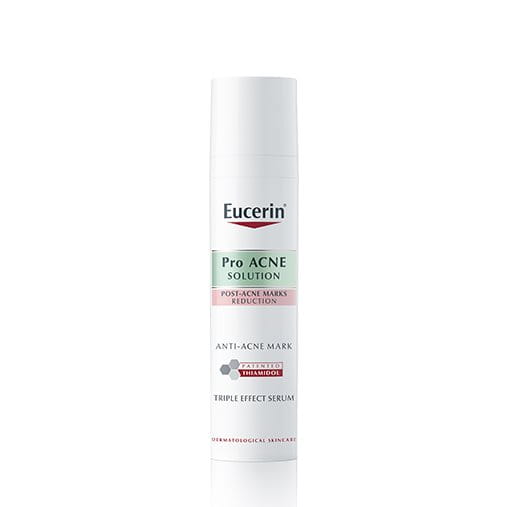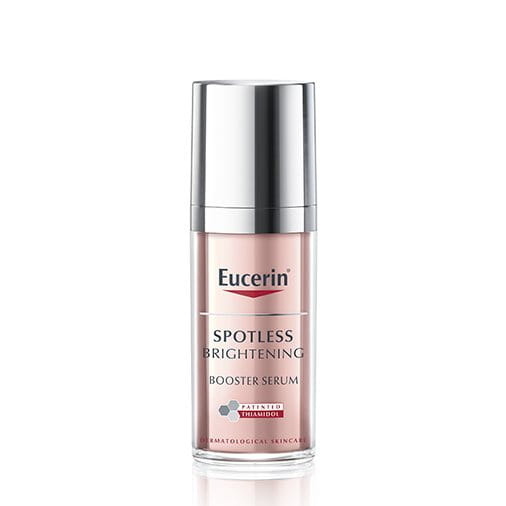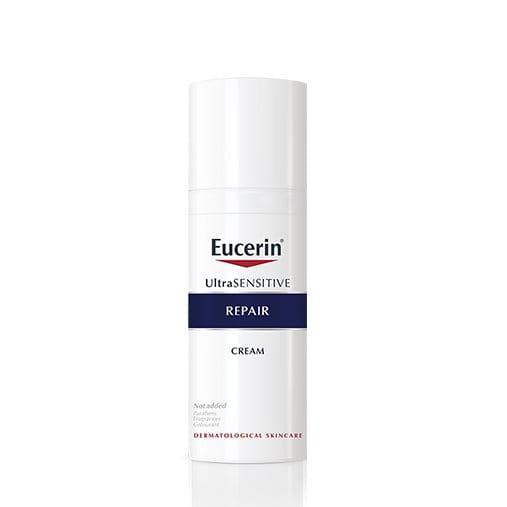Unlike many skin conditions hypersensitive facial skin can have no visible signs despite being intensely uncomfortable for sufferers. It is quite a common condition. Studies have found there to be a high prevalence of self-perceived sensitive skin across the industrialised world and dermatologists worldwide are reporting a rise in reported cases. Given its subjective symptoms, however, exact figures can't be verified.
Signs & symptoms
What are the signs and symptoms of hypersensitive facial skin?
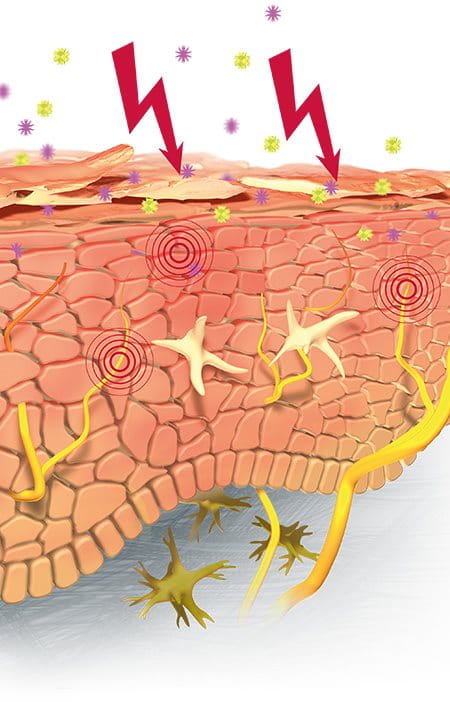
Hypersensitive skin - a more extreme version of sensitive skin - has three consistent signs and symptoms, collectively termed the Hypersensitive Skin Triangle: a compromised barrier function (which makes it more susceptible to irritants than healthy skin), hyper-reactive sensory fibres in the epidermis and finally, redness, often caused by inflammation.
The impaired skin barrier also results in increased levels of trans-epidermal water loss which can lead to dryness of the facial complexion.
Significantly the sensory fibres located in the epidermis react faster and much stronger than in normal skin and are easily activated by stressors triggering unpleasant sensations which are subjectively, but not uniquely, described as stinging, burning or tightness.

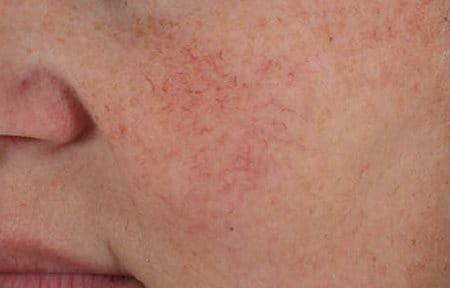
These non-visible sensations can only be judged on anecdotal accounts. This makes diagnosis difficult as different people have different levels of pain tolerance and descriptions can vary from person to person.
The sensations can come and go, depending on exposure to triggers. Hypersensitive facial skin is extremely vulnerable to psychological, environmental, mechanical and hormonal factors and it is common for it to react to exposure to external factors such as chemicals, fragrances and detergents. These factors are usually harmless in normal, healthy skin.
Hypersensitive skin is often linked to dry skin and acne-prone skin. However, it is possible to have both conditions without the stinging and burning sensations so it doesn't follow that all people with dry or acne-prone skin have hypersensitive skin. Similarly hypersensitive skin is susceptible to redness which can lead to Couperose-prone skin and even Rosacea. Again it is possible to have these conditions without the facial skin being considered hypersensitive.
Hypersensitive redness tends to appear on the cheeks, T-zone and chin.
Read more about hypersensitivity in general.
Read more about redness-prone facial skin.
Attention
If you suspect you have Rosacea seek the advice of a doctor or dermatologist as early treatment can reduce the chances of the condition progressing.
Causes & Triggers
Causes and triggers of hypersensitive facial skin
While symptoms differ from one individual to another the common denominator for all hypersensitive facial skin sufferers is the ongoing tingling, stinging, burning or similar sensations. Some people experience dryness or pimples as well, while others are prone to redness (Couperose-prone or even Rosacea).
These visible and non-visible symptoms can be triggered by a range of internal and external stressors. Again, these differ from person to person but there are common reactors that have been known to exacerbate the condition. These are:


Environmental factors such as dramatic temperature changes, extreme hot or cold, wind, sun or atmospheric pollution. Increasingly bad air pollution, especially in urban environments, has been blamed for the growth of reports of hypersensitive facial skin conditions.
External factors. These tend to be chemicals or harsh cosmetic ingredients that irritate the skin, such as certain cleansing products, fragrances, unsuitable detergents, excessively calcareous water, baths, showers and swimming pools. An increase in people reporting allergic reactions over recent years has raised awareness of the need for 'pure' or '0%' cosmetics and detergents - those containing only a limited number of ingredients.
Psychological factors like stress, anger or intense emotions can trigger hypersensitivity as can hormonal factors such as the menstrual cycle.
Mechanical factors that put pressure on the skin can damage the already impaired barrier function, activating underlying sensory fibres.
Contributing factors
Further contributing factors
The general rule of thumb with hypersensitive facial skin is "less is more". In other words, keep things simple and don't exposure skin to any unnecessary ingredients such as perfume or dye.


Also, take care with diet as spicy foods and alcohol can act as stressors.
Different people react to different stimulants so it is important to identify the factors that affect each individual. For example, with cosmetics and skin care creams it is a good idea introduce new products one at a time - ideally doing a small patch test on the forearm before using it on the face. Reaction may not be immediate so a new ingredient should not been introduced until any previous ones have been shown to produce no adverse reactions.
Another way of avoiding triggers is to keep a diary, noting the day's temperature, exposure to pollution, emotional state, contact with cosmetics or detergents etc. and compare these with any visible or non-visible reactions. By identifying triggers it is possible to make lifestyle changes to minimise the impact of these factors. For example, psychological factors could be reduced with yoga or meditation.
Some people find exposure to the sun, or even the SPF ingredients in certain sun creams to be an issue. Again, many sun creams have 'pure' formulas and use anti-contamination packaging.
Read more about protecting facial skin from the sun.
Solutions
Skin care solutions for hypersensitive facial skin
"Hypersensitive" is not a permanent skin type, but rather a skin condition that can be brought back to normal. It doesn't have to be a burden. It simply needs special, proactive skin care.
To successfully care for hypersensitive facial skin, it is important to address all three features of hypersensitive skin (collectively termed the Hypersensitive Skin Triangle):
- Barrier defects. Hypersensitive skin is characterised by a compromised skin barrier and is therefore more prone to irritations.
- Hyper-responsive sensory fibres. When skin is sensitive the sensory fibres in the epidermis react faster and stronger than in normal skin, triggering unpleasant sensations.
- Redness. Internal and external factors can trigger an increase in the level of stress of the skin causing redness.
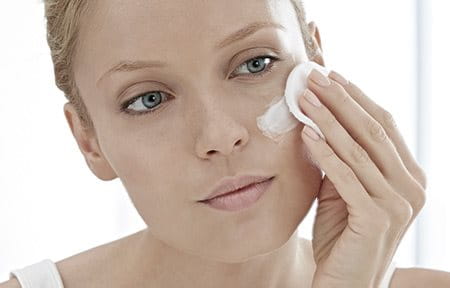
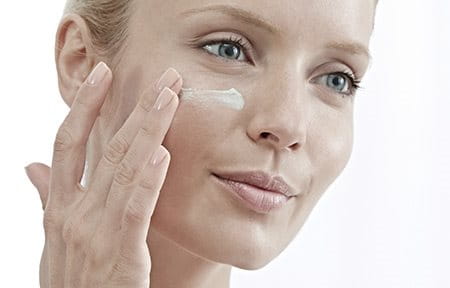
The impaired barrier can be improved by regular moisturisation to counteract the trans-epidermal water loss and prevent skin drying out. Moisturisers for hypersensitive skin should contain only a limited number ingredients to reduce the chance of intolerance and allergic reactions and, to protect the formulas from oxidation, they should use anti-contamination packaging.
Eucerin has now included an active ingredient called SymSitive* in its Hypersensitive Skin ranges. SymSitive* reduces hyper-reactions of the sensory fibres and balances the sensitivity threshold of the skin. It actively and instantly soothes irritations and unpleasant skin sensations for instant and long-lasting skin comfort.
For redness-prone skin Licochalcone A, a natural anti-inflammatory and anti-oxidant, quickly calms skin irritations and visibly reduces redness.
In severe cases of inflammation and redness, such as Rosacea, sufferers may want to hide the visible signs.
* =reg.tm of Symrise AG, Germany
Our brand values

We deliver a holistic dermo-cosmetic approach to protect your skin, keep it healthy and radiant.

We work together with leading dermatologist and pharmacist partners around the world to create innovative and effective skincare products they can trust and recommend.

For over 100 years, we have dedicated ourselves to researching and innovating in the field of skin science. We believe in creating active ingredients and soothing formulas with high tolerability that work to help you live your life better each day.

